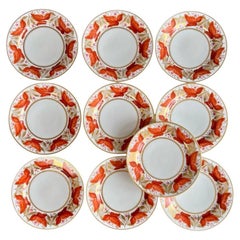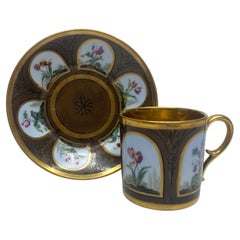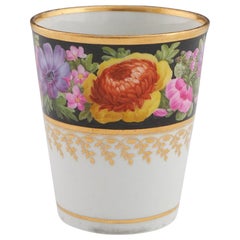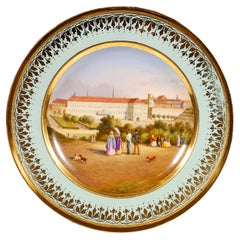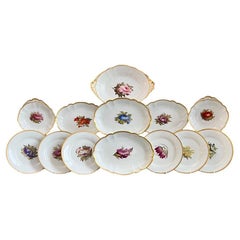Early 1800s Porcelain
30
to
4
20
10
30
30
30
9
7
4
4
2
673
2,456
3,809
933
1,046
1,331
837
160
75
232
209
111
207
358
253
276
69
29
28
1
1
28
21
19
4
2
10
5
2
2
1
Period: Early 1800s
Barr Flight & Barr Set of 10 Plates, Neoclassical Orange Vines, 1804- 1813
Located in London, GB
This is a fabulous set of large plates made by Barr, Flight & Barr between 1804 and 1813. The plates are decorated with a beautiful and famous pattern of bright iron red/orange vines...
Category
English Neoclassical Antique Early 1800s Porcelain
Materials
Porcelain
Paris porcelain coffee can & saucer, c. 1810.
Located in Gargrave, North Yorkshire
A fine Paris porcelain coffee can and saucer, possibly Dihl Et Guerhard, c. 1810. The coffee can, hand painted in the style of Gerard van Spaendonck, with ...
Category
French Empire Antique Early 1800s Porcelain
Materials
Porcelain
Flight and Barr Floral Beaker c1800
Located in Tunbridge Wells, GB
Heading : Flight and Barr beaker
Date : c1800
Period : George III
Marks : Flight & Barr Worcester Manufacturers to their Majisties and an impressed B.
Origin : Worcester, England
Co...
Category
British George III Antique Early 1800s Porcelain
Materials
Porcelain
Coalport John Rose Porcelain Dessert Service, Imari Pattern, ca 1805
Located in London, GB
This is a rather stunning 25-piece dessert service made by John Rose at Coalport around the year 1805. It consists a centre piece on four feet, two oval dishes, two shell dishes, two...
Category
English George III Antique Early 1800s Porcelain
Materials
Porcelain
Viennese Imperial Porcelain Splendour Plate, 'K.k. Hofburg Á Vienne', 1802
Located in Vienna, AT
Porcelain picture plate with a fine polychrome painted veduta: in the mirror a view of the Vienna Hofburg, the Leopoldine Wing with ceremonial apartments and the outer Burgplatz, see...
Category
Austrian Baroque Antique Early 1800s Porcelain
Materials
Porcelain
Barr Flight & Barr Part Dessert Service, Flowers by William Billingsley, 1808-10
By Barr, Flight & Barr Worcester, William Billingsly
Located in London, GB
This is a stunning part dessert service made by Barr Flight & Barr in Worcester, and painted with naturalistic flowers by William Billingsley between 1808 and 1810. The service consists of one deep central oval dish, four slightly smaller oval dishes, two round one-handled dishes, and six plates.
Provenance: The Charles Dawson Collection. One of the items has a label of the London Ceramic...
Category
English Regency Antique Early 1800s Porcelain
Materials
Porcelain
Viennese Imperial Porcelain Splendour Plate, Playing Cupids As Hunters, 1805
Located in Vienna, AT
Porcelain picture plate with fine polychrome painted scenery:
In the mirror five winged cupids dressed as hunters with dog in a summer landscape agains...
Category
Austrian Baroque Antique Early 1800s Porcelain
Materials
Porcelain
Regency Period Coalport Porcelain Chinoiserie Dish with Yellow Dragon & Lions
Located in Downingtown, PA
Coalport Porcelain Chinoiserie Dish with Yellow Dragon
Circa 1805-10
The Coalport porcelain shaped oval dish is painted in an Imari coloration with the center depicting a yellow dragon with green scales...
Category
English Regency Antique Early 1800s Porcelain
Materials
Porcelain
Coalport John Rose Thumb and Finger Pattern Teacup & Saucer
Located in Stamford, CT
Early 1800s Coalport John Rose Thumb and Finger teacup and saucer: Hand painted, richly colored and detailed cup and saucer with hand painted gold band. No makers mark or signature. ...
Category
English Regency Antique Early 1800s Porcelain
Materials
Porcelain
English porcelain botanical dish, ‘Hyacinth’, c. 1800
Located in Gargrave, North Yorkshire
English porcelain botanical dish, ‘Hyacinth’, c. 1800. Hand painted to the centre, with a titled study of a Hyacinth. The border with a stylised Classical leaf scroll motif, in iron ...
Category
English Georgian Antique Early 1800s Porcelain
Materials
Porcelain
Early Worcester Flight & Barr Yellow Porcelain Cup
Located in Fort Lauderdale, FL
An early Worcester Flight & Barr bright yellow beaker with gilding and a finely painted sepia scene of a landscape. The scene, possibly painted by John Pennington, shows two figures ...
Category
English Grand Tour Antique Early 1800s Porcelain
Materials
Porcelain
Coalport John Rose Pearlware Dessert Service, Orange with Silver Vines, ca 1800
Located in London, GB
This is a stunning and extremely rare dessert service made by John Rose at Coalport probably around the year 1800, shortly after Rose bought up the Caughley factory. It consists of a large centre piece comport, one sauce tureen with cover, two oval dishes, two square dishes, two shell dishes, and eight plates. The service is beautifully decorated in the Neoclassical style.
Coalport was one of the leading potters in 19th and 20th Century Staffordshire. They worked alongside other great potters such as Spode, Davenport and Minton, and came out with many innovative designs. When we say "Coalport" we usually think of the one Coalport factory that became famous, but in its beginning years there were two factories, one run by John Rose and the other by his brother Thomas Rose. Thomas Rose went into partnership with Robert Anstice and Robert Horton and they were located directly opposite John Rose, across the canal. John Rose had bought up the local Caughley factory in 1799. The brothers' factories had much in common with each other and they shared many different shapes and patterns. Ultimately, the John Rose factory proved more profitable and John Rose bought Thomas' factory in 1814, making it the one Coalport factory that became so famous. Many of the Coalport items, of either factory, are now collectors' items.
This service is made of pearlware, which leads us to believe that it might have been made at the old Caughley premises, which had kilns for pearlware - the later Coalport items are not known to be made of pearlware but the shape of the dishes and the sauce comport are clearly a Coalport shape.
All items have a beautiful deep orange ground - they were done in different firings as the colour is not entirely consistent, which makes the service very charming. The rims are set off with a beautiful vine pattern in silver, which makes the service even more rare as this was not done often.
The items are unmarked, as is usual for that era, except the odd "B", which is probably the gilder's tally mark.
CONDITION REPORT The service is in good usable condition with some minor flaws: there is some crazing and wear throughout, which is to be expected of pearlware of this era. The centre piece comport has a slight crack through the side, which is not very visible. One of the plates has a chip on the front of the rim as well as three lines coming off the rim; one has a chip on the underside of the rim; and one has a line coming off the rim. Neither of these stand out and the plates are entirely stable.
Antique British china...
Category
British Neoclassical Antique Early 1800s Porcelain
Materials
Pearlware
Spode Porcelain Teacup Trio, Red Imari Dollar Pattern, Regency, ca 1810
By Spode
Located in London, GB
This is a beautiful orphaned teacup made by Spode in about 1810. It bears a beautiful Japanese-inspired Imari pattern.
Spode was the great pioneer among the Georgian potters in England. Around the year 1800 he perfected the bone china recipe that has been used by British potters ever since, and he was also the leading potter behind the technique of transferware, making it possible for English potters to replace the Chinese export china, which had come to an end around that time, with their own designs. This was fundamental to a thriving industry that would last for about 150 years and provide half the world with their tableware. Spode porcelain is regarded as one of the highest quality porcelains around; for a soft-paste porcelain it is surprisingly hard and fine, and has a wonderful bright white colour.
The pattern on this can is called "Dollar" pattern, a very famous pattern that was used by English potters in the 18th and early 19th Century. It is obvious why it is called “dollar” - but its origin is less obvious! It is thought that this pattern was derived from a very old Chinese pattern depicting a tree with elaborate foliage that hides a Chinese character representing longevity or happiness. Traditionally, this went with a an image called “Taotie”, which was used on very ancient bronze vases...
Category
English Regency Antique Early 1800s Porcelain
Materials
Porcelain
Pr. of Old Paris Miniature, Gilt Decorated Footed Urns With Garden Scenes, c1800
By Old Paris
Located in valatie, NY
Pair of Old Paris Miniature, Gilt Decorated Footed Urns with garden scenes, c1800. Miniature urns of this type are rare and the decoration is exceptional. The urns have bolted construction with scrolling handles and molded face mask terminals. The beautiful hand painted panels are of a seated young man and woman in traditional dress in a neoclassical garden with classical urns, landscaping, architecture and a fountain. Fine condition with mild typical wear to the gilt.
Trent Antiques has been a respected name in antiques for...
Category
French Empire Antique Early 1800s Porcelain
Materials
Porcelain
Chamberlains Worcester Porcelain Dish, Nelson or Fine Old Japan pattern, ca 1805
Located in London, GB
This is a striking square serving dish made by Chamberlains in Worcester around 1805. The dish bears the Fine Old Japan pattern, often called the Nelson pattern.
Robert Chamberlai...
Category
English Georgian Antique Early 1800s Porcelain
Materials
Porcelain
Derby Porcelain Teacup Trio, Green with Red Flowers, 1800-1810
By Derby
Located in London, GB
This is a wonderful "true trio" made by the Derby Porcelain factory between 1800 and 1810. The trio is decorated in an overglaze green ground with cheerful red flowers.
In the late 18th and early 19th Century cups and saucers...
Category
English Regency Antique Early 1800s Porcelain
Materials
Porcelain
English Porcelain Plate, Coalport, circa 1800
Located in New York, NY
In the "Dragon in Compartment" pattern.
Category
English Antique Early 1800s Porcelain
Materials
Porcelain
Coalport Plate, Windsor Castle with Deer, Sepia, Thomas Baxter, Georgian ca 1805
Located in London, GB
This is a beautiful and very rare dessert plate made by Coalport in circa 1805, which was the late Georgian era. The plate is decorated with a superbly painted named landscape of Win...
Category
English George III Antique Early 1800s Porcelain
Materials
Porcelain
Pair of First-Empire Period 2-Handled Porcelain Vases with Westall Venus Scenes
By Porcelaine de Paris, Richard Westall
Located in New York, NY
An incredible and rare pair of French Paris Porcelain First-Empire Period Winged Sphynx-form double- handled porcelain vases with mythological scenes of Venus and Cupids after Richar...
Category
French Empire Antique Early 1800s Porcelain
Materials
Porcelain
Pair of Empire Period Sèvres Porcelain Pale Blue and Faux Porphyry Ground Vases
Located in New York, NY
A very unusual and quite large pair of Empire period Sèvres Porcelain pale Celeste blue and faux porphyry ground vases. Each vase is intricately hand painted with meticulous detail and further adorned with 24-karat hand painted gilt decoration. The bases are a very unusual hand painted faux porphyry porcelain. Each vase and base is marked with various pressnumera and Sèvres signs...
Category
French Empire Antique Early 1800s Porcelain
Materials
Porcelain
19th century Rose Medallion Chinese Export Covered Chamber Bowl
Located in Savannah, GA
Rare early Canton Chinese Export porcelain Rose Medallion bowl with lid. Features include outstanding intricately painted birds, flower...
Category
Chinese Chinese Export Antique Early 1800s Porcelain
Materials
Porcelain
Six Regency Hand Painted Porcelain Plates by Coalport, circa 1805
Located in London, GB
Six Regency side plates by Coalport with hand painted panels of fruit, circa 1805. Cobalt borders support a gilded band of interlocking scrolls and finials with a gold dentil border....
Category
English Regency Antique Early 1800s Porcelain
Materials
Porcelain
Pair of Meissen Legume Dishes from the Marcolini Period, 18th Century
Located in Milano, IT
An elegant and rare pair of Meissen serving dishes from the Marcolini period. The pair of legume dishes is made of the finest porcelain. Under each saucer we find the Meissen manufac...
Category
German Neoclassical Antique Early 1800s Porcelain
Materials
Porcelain
Spode Double Handled Sugar Bowl and Cover
Located in New York, NY
Spode double handled sugar bowl and cover. Oval-shaped porcelain body, gilt with diamond and vine motifs, the base impressed with an “S” and numbered “6...
Category
English George III Antique Early 1800s Porcelain
Materials
Porcelain
Pair of Regency Hand Painted Porcelain Covered Dishes by Coalport, circa 1805
Located in London, GB
A pair of Coalport cobalt blue square covered vegetable serving dishes decorated with gilded bands of interlocking scrolls and finials. Hand paint...
Category
English Regency Antique Early 1800s Porcelain
Materials
Porcelain
Five Regency Hand Painted Porcelain Plates by Coalport, circa 1805
Located in London, GB
Five Regency side plates by Coalport with hand painted panels of flowers, circa 1805. Cobalt borders support a gilded band of interlocking scrolls and finials with a gold dentil bord...
Category
English Regency Antique Early 1800s Porcelain
Materials
Porcelain
Four Regency Hand Painted Porcelain Dishes by Coalport, circa 1805
Located in London, GB
Set of four Coalport dishes consisting of three oval serving dishes and one scalloped dish all by Coalport with cobalt borders and gilded bands of inter...
Category
English Regency Antique Early 1800s Porcelain
Materials
Porcelain
Pair of Chinese Blue Poudre Porcelain and Ormolu Vases in the Archaic Style
Located in New York, NY
An unusual pair of antique Chinese blue poudre porcelain and Chinese gilt bronze-mounted vases in the ancient archaic Chinese style. These vases date to the late 1700s-early 1800s, i...
Category
Chinese Antique Early 1800s Porcelain
Teacup Trio Coalport John Rose, Flowers in Gilt Squares and Stars, ca 1800
Located in London, GB
This is a beautiful true trio made by John Rose at Coalport around the year 1800. It consists of a teacup and a coffee can sharing one saucer. In the 18th and early 19th Century, th...
Category
English George III Antique Early 1800s Porcelain
Materials
Porcelain
Spode Porcelain Coffee Can, Neoclassical Cobalt Blue and Gilt, Georgian ca 1806
By Spode
Located in London, GB
This is a beautiful coffee can and saucer made by Spode around 1806. The set is decorated in a stunning pattern of dense gilt foliage and a cobalt blue band in the Neoclassical taste...
Category
English Neoclassical Antique Early 1800s Porcelain
Materials
Porcelain
Recently Viewed
View AllMore Ways To Browse
Square Chinese Plate
Cabinet Plate Royal
Antique Austria Porcelain
Beehive Mark
Pink And White Antique China
Chinese Serving Dish
Silver Dish Scene
Vintage Fire Table
Meissen Porcelain Birds
Antique Blue Spode
Antique Worcester China
Vintage White Coffee Cups
White Coffee Pot
Cobalt Blue Cup
Light Blue Antique Plates
Meissen Vase 19th
Antique Cake Plates Glass
Meissen Vase 19th Century
